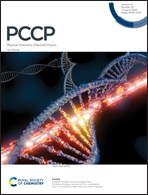Protobranching as repulsion-induced attraction: a prototype for geminal stabilization†
Abstract
Noncovalent interactions are traditionally defined within the context of their attractive components, such as electrostatics and dispersion. Sources of molecular strain are derived through the destabilization of Coulombic and exchange repulsion. Due to this binary designation, the underlying origin of geminal stability with respect to alkanes (referred to as protobranching) has been an active subject for debate between these competing perspectives. We recast this stabilization as a complementary (Gestalt) interaction between dispersion and exchange repulsion, each impacting the other. We use triplet hydrogen and argon dimer as foundational van der Waals adducts to develop a procedure for the visualization and quantification of both exchange repulsion, ΔρSCF, and medium-range correlation, ΔΔρ, as perturbations in electron density. We use the framework of the DFT-D3 correction to reproduce the shape of the dispersion potential at medium range and successfully model the trend in stability for the eighteen isomers of octane with a diverse series of functionals: BLYP, B3LYP, BP86, PBE, and PBE0. Collectively, our findings show that protobranching is a manifestation of steric repulsion-reduction in vibrational enthalpy and medium-range electron correlation.



 Please wait while we load your content...
Please wait while we load your content...